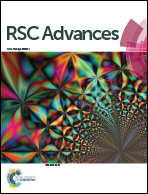Electrospun hollow ZnO/NiO heterostructures with enhanced photocatalytic activity†
Abstract
ZnO/NiO hollow nanofibers with high photocatalytic activity are successfully fabricated by impregnating electrospun polyethersulfone (PES) nanofiber webs in nickel acetate and zinc acetate solutions and subsequent thermal treatment. From scanning electron microscopy (SEM) and transmission electron microscopy (TEM) images, it can be observed that the morphology of the ZnO/NiO products is a hollow structure successively. According to statistics, the ZnO/NiO hollow nanofibers show diameters of approximate 414 nm with inner diameters of about 261 nm. Fourier transform infrared radiation (FTIR) and X-ray diffraction (XRD) measurements demonstrate that the product is composed of ZnO/NiO hollow nanofibers with hexangular structure ZnO and cubic structure NiO. The formation mechanism is studied in detail by TGA and DSC. The photocatalytic activity of the hollow ZnO/NiO heterojunction nanofibers for the degradation of methyl orange (MO) is much higher than that of pure ZnO and NiO nanofibers, which may be ascribed to the unique hollow structure and the highly efficient separation of photogenerated electron–hole pairs. Furthermore, the photocatalytic mechanism of the hollow ZnO/NiO nanofibers is expounded.


 Please wait while we load your content...
Please wait while we load your content...